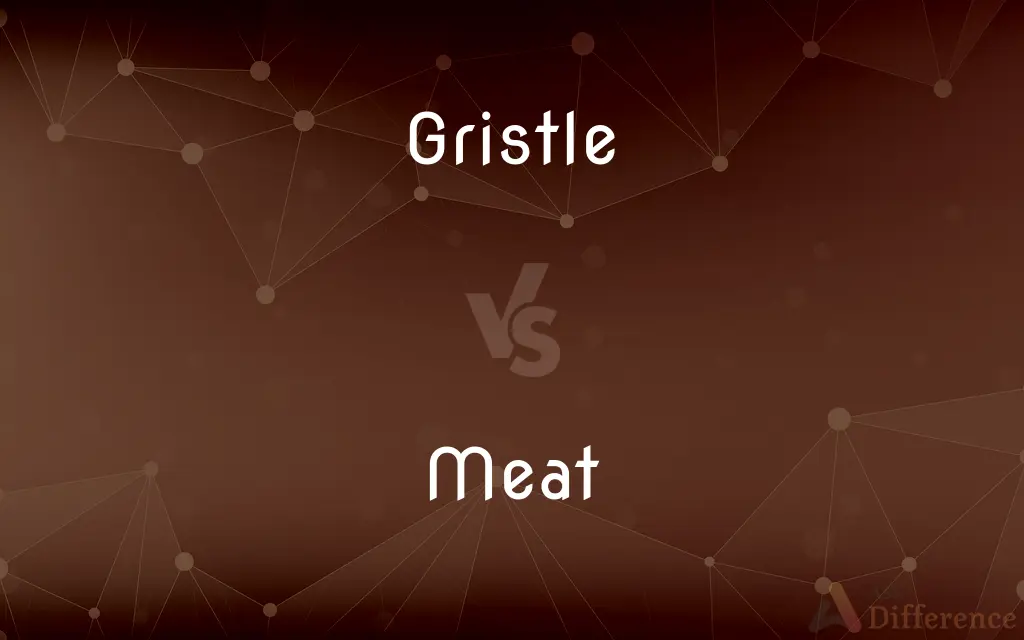Gristle vs. Meat — What's the Difference?
By Maham Liaqat & Fiza Rafique — Updated on May 7, 2024
Gristle, often found as tough, fibrous tissues in meat, is primarily collagen and does not easily break down during cooking, unlike meat, which is the edible flesh of animals, consisting mostly of muscle and fat.

Difference Between Gristle and Meat
Table of Contents
ADVERTISEMENT
Key Differences
Gristle refers to the tough, fibrous tissue in meat, mainly composed of collagen and connective tissues, which can be chewy and difficult to digest. Meat, on the other hand, encompasses all animal flesh that is consumed as food, which typically includes muscle fibers, fat, and sometimes bones.
In culinary contexts, gristle is usually considered undesirable due to its tough texture and difficulty to chew, whereas meat is valued for its nutritional content, flavor, and versatility in cooking.
During cooking, gristle does not break down as easily as the rest of the meat. This resistance to heat and moisture makes it less palatable and harder to prepare in a way that is enjoyable to eat. In contrast, the muscle parts of meat tenderize and develop flavor through various cooking methods such as grilling, roasting, or stewing.
While gristle is often removed before cooking or discarded after serving, meat forms the basis of a dish, providing protein, essential amino acids, and other nutrients vital for health.
Gristle may be more commonly found in certain cuts of meat that include larger amounts of connective tissue, such as certain cuts of beef or pork. This contrasts with more tender cuts of meat, which are higher in muscle content and more sought after for their taste and ease of preparation.
ADVERTISEMENT
Comparison Chart
Composition
Primarily collagen and connective tissues.
Muscle fibers, fat, and sometimes bone.
Culinary Value
Considered undesirable due to tough texture.
Valued for flavor, nutrition, and versatility.
Cooking Behavior
Does not break down easily; remains tough.
Tenderizes and develops flavor with cooking.
Nutritional Content
Low nutritional value.
High in protein and essential nutrients.
Common Usage
Often removed or discarded.
Forms the basis of dishes across cuisines.
Compare with Definitions
Gristle
Noted for its chewy and often unpleasant texture in cooked dishes.
Gristle can make certain cuts of meat less enjoyable to eat.
Meat
Edible part of an animal, primarily consisting of muscle and fat.
The butcher offered a variety of meats, including beef and pork.
Gristle
Less desirable part of meat, typically discarded or used in stock.
They used the gristle and bones to make a rich, flavorful stock.
Meat
Consumed in various forms, such as steaks, roasts, and ground.
They grilled steaks for dinner, enjoying the tender meat.
Gristle
Can be found in meat cuts with high amounts of connective tissue.
Cuts from the leg often contain gristle due to dense connective tissues.
Meat
Can be prepared in numerous ways, including smoking, frying, and baking.
They smoked the meat for several hours to enhance its flavor.
Gristle
Tough, fibrous tissue in meat, primarily made of collagen.
She found a piece of gristle in her steak that was hard to chew.
Meat
Often celebrated for its versatility and essential role in cuisines worldwide.
Meat plays a central role in many traditional dishes around the world.
Gristle
Connective tissue that is often removed before cooking or eating.
The chef trimmed the gristle off the meat before marinating it.
Meat
Serves as a primary source of protein in many diets.
His diet included a lot of meat to help build muscle mass.
Gristle
Cartilage, especially when present in meat.
Meat
Meat is animal flesh that is eaten as food. Humans have hunted and killed animals for meat since prehistoric times.
Gristle
Cartilage; now especially: cartilage present, as a tough substance, in meat.
Meat
The edible flesh of animals, especially that of mammals as opposed to that of fish or poultry.
Gristle
Bone not yet hardened by age and hard work.
Meat
The edible part, as of a piece of fruit or a nut.
Gristle
Cartilage. See Cartilage.
Meat
The essence, substance, or gist
The meat of the editorial.
Meat
(Slang) Something that one enjoys or excels in; a forte
Tennis is his meat.
Meat
Nourishment; food
"Love is not all.
Meat
The genitals.
Meat
(uncountable) The flesh (muscle tissue) of an animal used as food.
A large portion of domestic meat production comes from animals raised on factory farms.
The homesteading teenager shot a deer to supply his family with wild meat for the winter.
Meat
(countable) A type of meat, by anatomic position and provenance.
The butchery's profit rate on various meats varies greatly.
Meat
Food, for animals or humans, especially solid food. See also meat and drink.
Meat
A type of food, a dish.
Meat
(archaic) A meal.
Meat
(obsolete) Meal; flour.
Meat
(uncountable) Any relatively thick, solid part of a fruit, nut etc.
The apple looked fine on the outside, but the meat was not very firm.
Meat
(slang) A penis.
Meat
(colloquial) The best or most substantial part of something.
We recruited him right from the meat of our competitor.
Meat
(sports) The sweet spot of a bat or club (in cricket, golf, baseball etc.).
He hit it right on the meat of the bat.
Meat
(slang) A meathead.
Throw it in here, meat.
Meat
(Australian Aboriginal) A totem, or (by metonymy) a clan or clansman which uses it.
Meat
Food, in general; anything eaten for nourishment, either by man or beast. Hence, the edible part of anything; as, the meat of a lobster, a nut, or an egg.
And God said, Behold, I have given you every herb bearing seed, . . . to you it shall be for meat.
Every moving thing that liveth shall be meat for you.
Meat
The flesh of animals used as food; esp., animal muscle; as, a breakfast of bread and fruit without meat.
Meat
Dinner; the chief meal.
Meat
To supply with food.
His shield well lined, his horses meated well.
Meat
The flesh of animals (including fishes and birds and snails) used as food
Meat
The inner and usually edible part of a seed or grain or nut or fruit stone;
Black walnut kernels are difficult to get out of the shell
Meat
The choicest or most essential or most vital part of some idea or experience;
The gist of the prosecutor's argument
The heart and soul of the Republican Party
The nub of the story
Common Curiosities
Why is gristle considered undesirable in cooking?
Due to its tough and chewy texture, gristle is considered undesirable as it does not break down easily during cooking.
What exactly is gristle in meat?
Gristle is the tough, fibrous tissue found in meat, mainly composed of collagen and connective tissues.
What are the best cooking methods for meat to avoid toughness?
Slow cooking methods like braising or stewing are best for making tougher cuts of meat more tender.
How can I identify gristle when buying meat?
Gristle appears as white, thick fibrous bands within the meat and is tougher than the surrounding muscle tissue.
Can gristle be made edible?
While gristle can be softened somewhat by long cooking methods like stewing, it generally remains tougher than the rest of the meat.
Is there any nutritional value in gristle?
Gristle is mostly collagen and has minimal nutritional value compared to muscle meat.
How should gristle be handled when found in cooked dishes?
Gristle can be removed before eating to avoid the unpleasant texture.
Are there any health concerns associated with consuming gristle?
Consuming small amounts of gristle is not harmful, but it may be difficult to digest for some people.
What cuts of meat have the least gristle?
Tender cuts like tenderloin or sirloin have less gristle compared to tougher cuts like chuck or brisket.
Can gristle be used in any culinary applications?
While not ideal for direct consumption, gristle can be used along with bones to make stocks or broths.
Why does gristle not break down during cooking like meat does?
Gristle consists of dense collagen that is resistant to heat and does not melt or tenderize as easily as muscle fibers.
What is the difference between gristle and fat in meat?
Gristle is made of collagen and is tough, whereas fat is softer, adds flavor, and can render down during cooking.
How does the presence of gristle affect the quality of meat?
The presence of gristle can negatively impact the perceived quality and enjoyment of meat due to its tough texture.
Is all gristle the same in different types of meat?
The amount and toughness of gristle can vary between different types of meat and different cuts.
How can I minimize gristle in my meat dishes?
Choosing high-quality cuts and proper cooking techniques can minimize the presence of gristle in meat dishes.
Share Your Discovery

Previous Comparison
Safelight vs. Darkroom
Next Comparison
Cereal vs. MilletAuthor Spotlight
Written by
Maham LiaqatCo-written by
Fiza RafiqueFiza Rafique is a skilled content writer at AskDifference.com, where she meticulously refines and enhances written pieces. Drawing from her vast editorial expertise, Fiza ensures clarity, accuracy, and precision in every article. Passionate about language, she continually seeks to elevate the quality of content for readers worldwide.
















































